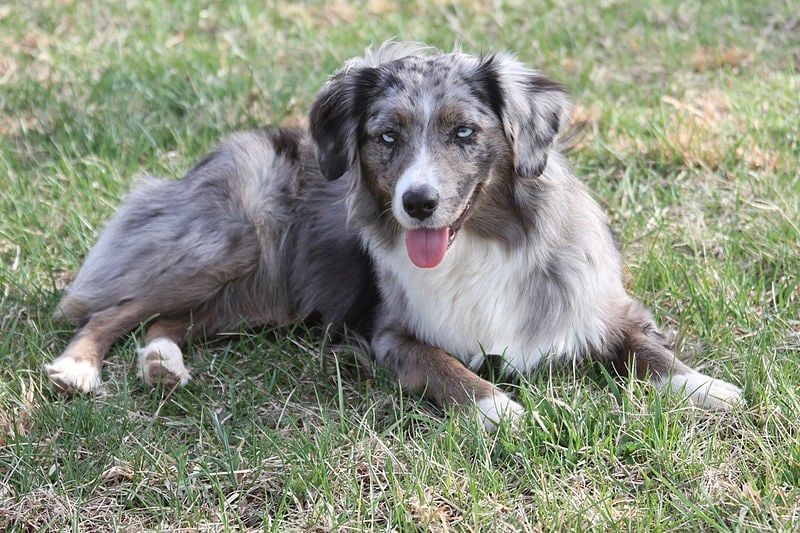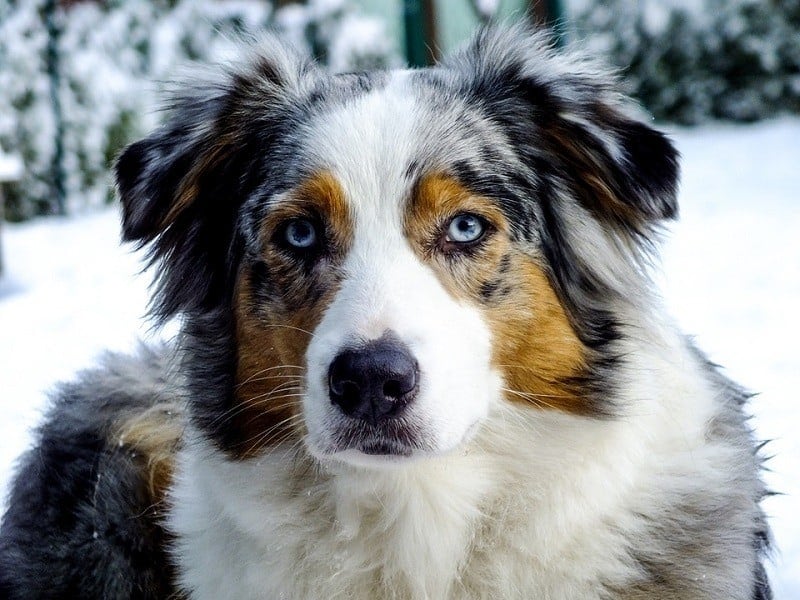Australian Shepherds, or “Aussies” to their friends – which they make on every walk! – are sweet-natured, hard-working, energetic dogs. Despite their name, they’re actually an American breed, famous for working with cowboys and starring in movies and rodeos.
Aussies arrived in the American West after a long journey around the world. Their ancestors, the Pyrenean Shepherds, came to Australia with Basque travelers from the north of Spain. In the Australian Outback, the Basques mated their herding dogs with Collies from Britain, producing the Aussie we know and love today. Descendants of the Basques then moved to California, where their dogs impressed the local cowboys with their intelligence, kindness, and loyalty.
Today, if there’s a job for a dog, you’ll find an Australian Shepherd doing it. They’re seeing-eye dogs, therapy dogs, search-and-rescue dogs, K-9 police officers, and of course shepherds. And they still love doing tricks at rodeos!
The American Kennel Club recognizes four coat colors for purebred Aussies: black, blue merle, red, and red merle. Within these groups, AKC recognizes different combinations of markings, for a total of 14 different colors. If you find an Aussie in a color that isn’t on this list, they’ll still be an adorable, loving work dog, but not technically a purebred.
Australian Shepherd Colors
Australian Shepherds come in 4 colors, although these can be mixed and matched into different combinations.
The 4 recognized Australian Shepherd colors are:
1. Solid Black Australian Shepherd
Solid color is controlled by a recessive gene in Australian Shepherds, so it’s rare to see them born with only one color. Although unlikely, it’s not impossible: you can find totally black Aussies on ranches and suburban sidewalks alike without markings.
An Aussie doesn’t have to be completely unblemished to count as a solid color, but any white or tan spots will be very understated.
Black Aussies almost always have brown eyes, though the shades can vary from light to dark. Very occasionally, you’ll see an all-black Aussie with gold-flecked hazel eyes – if you do, make sure to take a picture.
2. Black Bicolor Australian Shepherd

Black bicolor, shortened to “black bi,” refers to an Aussie whose only coat colors are black and white (sometimes simply called a black and white Australian Shepherd). A black and white Australian Shepherd’s coat is most often white from its face down to its front paws, and solid black everywhere else, from the back of its head to its tail. It might also have white “points”: spots of color above its eyes.
Some black Australian Shepherds have tan as their second color instead of white. A black-and-tan Aussie might have tan spots on its eyes, cheeks, throat, chest, or legs. Though they have two colors, they’re not “black bi,” since that term refers exclusively to white-secondary Aussies.
3. Black Tricolor Australian Shepherd

A three-colored black Australian Shepherd, or “black tri Australian Shepherd,” has both white and tan highlights. The white markings are most common on its muzzle, chest, stomach, and paws, while the tan marks are most prominent on its eyes, cheeks, and legs.
The black tri Australian Shepherd is one of the most popular coat colors of the whole Australian Shepherd breed. Since black is the dominant color, their eyes are still light to dark brown.
4. Solid Red Australian Shepherd
Red is a recessive gene, which means it only expresses itself when the dominant black gene isn’t there. Red Australian Shepherds are a bit harder to breed, but that just makes these rare beauties all the more precious.
Aussie coats can grow in several different shades of red. Cinnamon, the lightest, is almost gold in some lights, while the darkest shade, liver, is close to dark gray or black. In between, red Australian Shepherds can be auburn, chestnut, ruby, and more.
With the red gene being recessive, and solid-colored Aussies being the rarest, solid red Aussies are the rarest of them all. It’s a cause for celebration if you meet one!
5. Red Bicolor Australian Shepherd

As with black bi, red bi refers to a red and white Australian Shepherd. Red bi Aussies have white markings on their faces, chests, and legs, and sometimes on the backs of their necks as well. From the forelegs backward, they’ll be entirely red.
All red bicolor Aussies are red and white. Tan markings don’t occur in red Aussies without any white present, either solid or merle.
6. Red Tricolor Australian Shepherd

A red tri Australian Shepherd has a red and white coat with copper points and markings. On top of their base red coats, red tricolors can have white on their paws, fronts, and faces, with copper highlights most likely to occur on the face and legs.
Amber is the most common eye color for all three kinds of red Aussie, which provides a lovely complement to their coats. Some red Aussies have blue eyes. A few even have heterochromia, with one eye amber and the other blue.
7. Blue Merle Australian Shepherd
Merle is the dominant pattern gene in Australian Shepherds, so you’ll see it much more often than you’ll note solid black or red coats. In case you’re not familiar with the world, “merle” means a marbled coat, where lighter and darker shades are layered to create a rich blended pattern.
Merle Aussies can be black or red, but when a black Australian Shepherd has the merle gene, it’s called a “blue merle” instead. Take a look at the picture and you’ll see why: the black spots mix with patches of gray, in such a way that the whole picture looks blue from a distance.
A solid blue merle Aussie is marbled over its entire coat. Shades of gray range from charcoal to silver, often on the same dog. Aussies with this coloration are rare but unforgettable.
8. Blue Merle Bicolor Australian Shepherd

A blue merle bi Aussie can mix either tan or white with its marbled base color. White mixed with blue merle can be as understated as a single patch on the chest or can extend as far as the dog’s chest, forelegs, and middle.
Blue merle and tan Aussies turn up from time to time. They have tan or copper points on their eyebrows, and sometimes tan beards, giving them a distinguished air.
You May Also Like: How Much Does an Australian Shepherd Cost? (2021 Price Guide)
9. Blue Merle Tricolor Australian Shepherd

Blue merle tri Australian Shepherds are another extremely popular purebred color combination. With white ruffs and faces, tan cheeks, ears, and legs, and cloudy blue merle all down their backs, these are some of the most gorgeous dogs you’ll ever see. Only a few kinds of dog could win both a kennel club show and a rodeo contest, and these Aussies are one of them.
Blue merle Australian Shepherds tend to have either blue or brown eyes, and sometimes one of each. Strikingly, their eyes can be marbled just like their fur.
10. Red Merle Australian Shepherd
Red merle Australian Shepherds come from the combination of a merle pattern gene and a red color gene. While marbling a black coat results in a cloudy blue-gray, marbling a red coat creates an exotic sandstone effect. It’s sure to remind you of the wild outback where your Aussie’s ancestors began herding sheep.
To be a solid red merle Australian Shepherd, they don’t need to be perfectly marbled over its entire body. A few copper and/or white patches are acceptable before it’s officially considered a different coat color.
Red merle Australian Shepherds often have marbled eyes as well, with flecks of color in their irises granting them a deep, vivid gaze. The dominant colors are blue with brown marbling, brown with blue marbling, and in very special dogs, one of each.
You may also like: Are Australian Shepherds Good Family Dogs?
11. Red Merle Bicolor Australian Shepherd
Australian Shepherds with red merle bicolor coats can have white trim on their faces, necks, or legs. Sometimes, white is also threaded through the merle itself, adding a new dimension to the complex colors. On their faces, red merle bicolor Aussies sometimes have red and white spots mixed together, for a spray of color that looks a lot like adorable freckles.
Red merles almost never have tan points without white trim. When they do, the tan/copper is so understated that AKC doesn’t count it as its own shade.
12. Red Merle Tricolor Aussie Shepherd

A red merle tricolor Aussie matches a marbled red base with tan highlights and white trim. The white can cover their faces, chests, legs, and sometimes bellies, while the copper is most noteworthy above their eyes and on the tips of their paws.
An interesting (and important) fact about the merle gene: reputable breeders will never mate a merle with another merle. There’s a risk that two merles could give birth to a litter of excessively white puppies. Without pigments near their ears and eyes, Aussies develop bad eyesight, poor hearing, and other pains as they grow.
Unrecognized Colors
Some Australian Shepherd colors aren’t accepted by the American Kennel Club. While this technically makes them mutts, these patterns can still turn up in purebred Aussie lines – they’re just controlled by exceptionally rare recessive genes.
- Dilute Aussies mix any of the standard coat colors with a gene that makes them appear much lighter. Black turns blue, red turns beige, and merles turn airier. While dilute coloration is a health concern in other breeds, so far, it seems to be fine for Australian Shepherds.
- White Australian Shepherds are a possible result of breeding two merles together, as described above. They’re often unhealthy, so honest breeders avoid litters of white Aussies at all costs.
- Yellow Aussies look a lot like Golden Retrievers. The possible shades vary as widely as the red and black options do, from a pale yellow to a rich, sandy gold. The yellow gene replaces the base color everywhere except the nose – it’s common to see yellow Aussies with black or mahogany noses. Yellow Aussies can also have white patches.
Wrap-Up
Australian Shepherds were bred to work. Along the way, though, they acquired lovely coats, intelligent eyes, and caring demeanors. That doesn’t always help them herd sheep or cows, but it does enrich the lives of everybody lucky enough to own one.
If you’re thinking of adopting your very own Aussie, you now know all the different types to look for. We wish you the best of luck in finding a new best friend with the perfect color of coat!
Related Reads:
- Are Australian Shepherds Hypoallergenic?
- How to Train Your Australian Shepherd: 8 Easy Tips
- Australian Shepherd Grooming: Complete & Easy Guide
Featured Image Credit: Petra Heike Laicher, Pixabay
Contents
- Australian Shepherd Colors
- The 4 recognized Australian Shepherd colors are:
- 1. Solid Black Australian Shepherd
- 2. Black Bicolor Australian Shepherd
- 3. Black Tricolor Australian Shepherd
- 4. Solid Red Australian Shepherd
- 5. Red Bicolor Australian Shepherd
- 6. Red Tricolor Australian Shepherd
- 7. Blue Merle Australian Shepherd
- 8. Blue Merle Bicolor Australian Shepherd
- 9. Blue Merle Tricolor Australian Shepherd
- 10. Red Merle Australian Shepherd
- 11. Red Merle Bicolor Australian Shepherd
- 12. Red Merle Tricolor Aussie Shepherd
- Unrecognized Colors
- Wrap-Up








